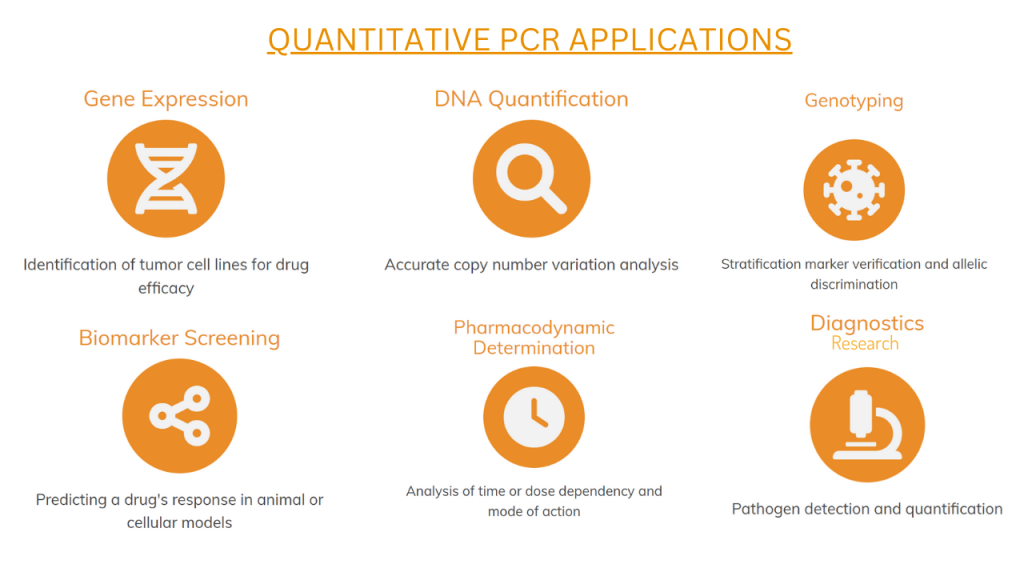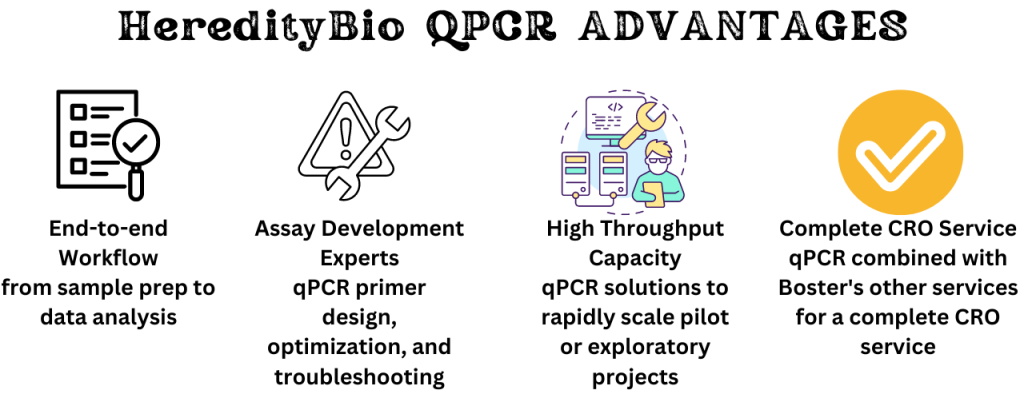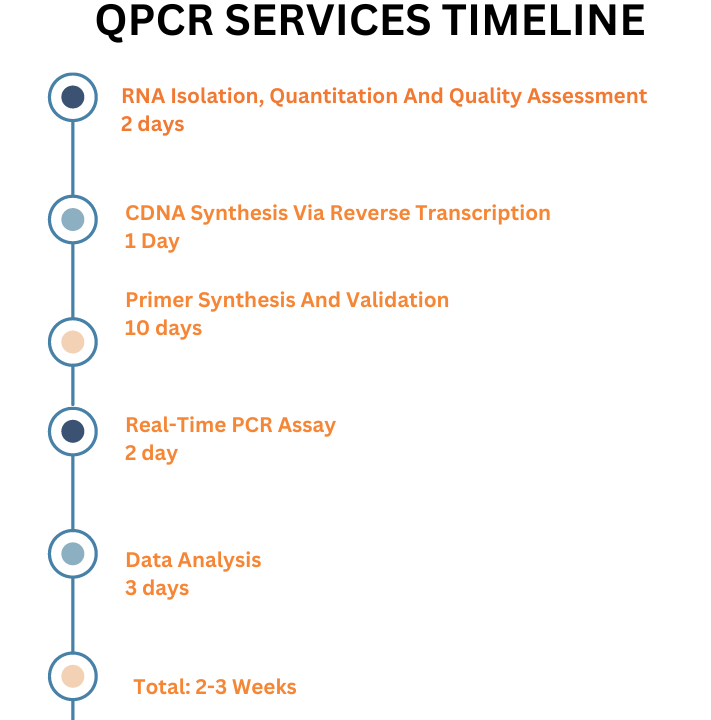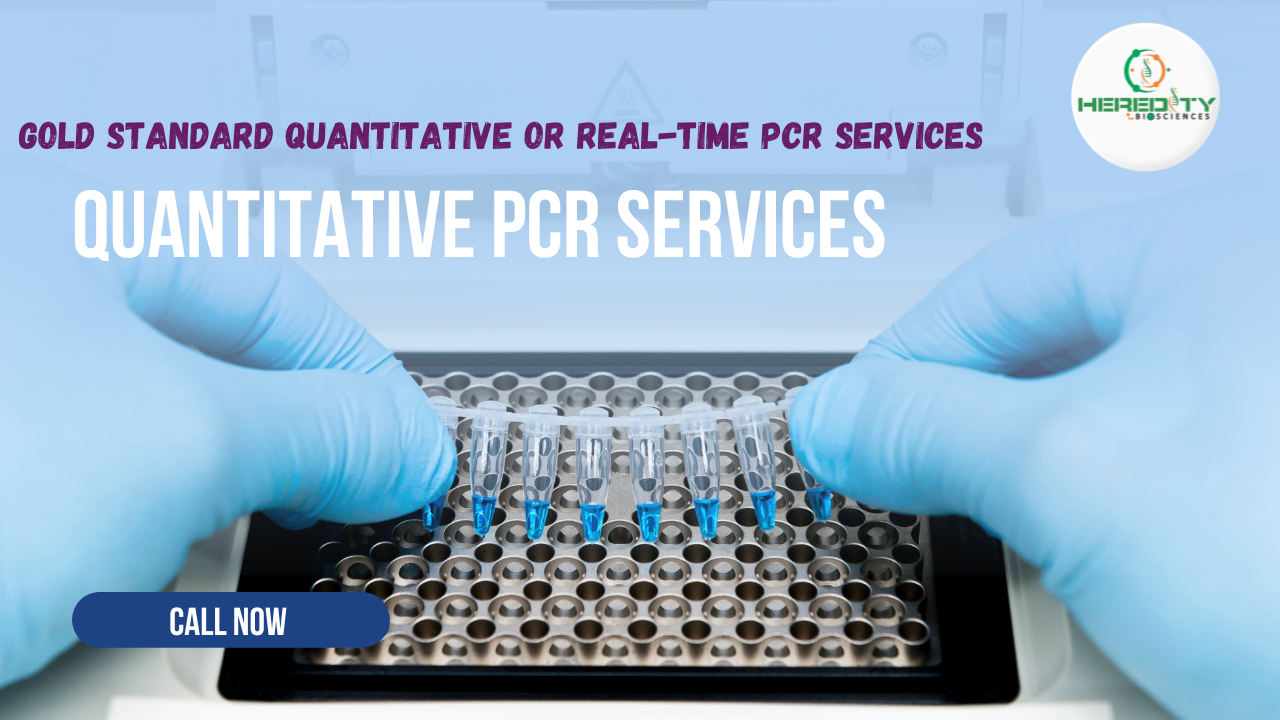QUANTITATIVE PCR SERVICES
Quantitative Real-time PCR (qPCR) stands as the gold standard for precise nucleic acid quantification in genomics research, biologics testing, and drug discovery. Our team of qPCR experts at Boster is enthusiastic about accelerating your research with our fast, sensitive, and reliable services. Trust us to provide accurate and efficient quantification, empowering your endeavours in the realm of genomics and beyond. Explore the precision of qPCR with Boster – where excellence meets your research needs.
FREE QUOTE FOR QPCR SERVICES
Free quote for qPCR Services
Gold Standard Quantitative Or Real-Time PCR Services


Call Now

SAMPLE REPORT
WHAT IS QUANTITATIVE OR REAL TIME PCR?
Real-Time PCR (RT-PCR) or Quantitative PCR (qPCR) serves as a sensitive and reproducible method for gauging gene expression levels in an organism. Essentially, it reveals the quantity of a specific DNA section in a sample in real-time. Recognized as the “Gold Standard” for DNA and RNA quantification and genotyping, it proves invaluable in drug discovery, quantifying changes in mRNA expression of drug targets, PD markers, or predictive biomarkers.
qPCR, an extension of PCR, utilizes nucleotides and primers for amplification, with fluorescent dyes or DNA probes added to detect PCR products as they emerge. Specific nucleic acids can be quantified through Absolute Quantification, comparing the sample to a DNA standard, or Relative Quantification, using internal reference genes within the sample. Offering fast and high-throughput detection and quantification, qPCR facilitates simultaneous visualization of all newly formed DNA amplicons.
FAQs
Q1. What Are The Applications Of QPCR?
There are multiple research applications based on qPCR. These include gene expression analysis, genotyping, allelic discrimination, single nucleotide polymorphism (SNP) detection, microbe and pathogen detection, species abundance quantification and many others.
Q2. What Is The Difference Between PCR And QPCR?
Polymerase Chain Reaction (PCR) and Quantitative Polymerase Chain Reaction (qPCR) are both molecular biology techniques used to amplify and analyze DNA. However, they differ in their applications and the information they provide.
- PCR (Polymerase Chain Reaction):
- Purpose: PCR is primarily used for DNA amplification.
- Detection: It provides qualitative information, indicating the presence or absence of a specific DNA sequence.
- End-point Analysis: PCR involves a fixed number of cycles, and the results are typically analyzed at the end of the reaction.
- Output: The final output is usually visualized on an agarose gel, and the presence of bands indicates successful amplification.
- qPCR (Quantitative Polymerase Chain Reaction):
- Purpose: qPCR is designed for both DNA amplification and quantification.
- Detection: It provides quantitative information, allowing the measurement of the initial amount of the target DNA.
- Real-time Monitoring: qPCR continuously monitors the amplification process in real-time, allowing for the detection of fluorescence at each cycle.
- Output: The results are expressed as cycle threshold (Ct) values or in a quantitative format, providing information on the relative or absolute abundance of the target DNA.
In summary, while both PCR and qPCR involve DNA amplification, qPCR adds the capability of quantifying the amount of DNA present in the starting sample. qPCR is particularly useful for applications where accurate measurement of DNA concentration or gene expression levels is essential, such as gene expression studies, pathogen detection, and quantification of nucleic acids in research and diagnostic settings.
Q3. What Are The Sample Requirements For My QPCR Assay?
The sample requirements for your qPCR assay depend on the type of nucleic acid you are analyzing. In general, for DNA-based qPCR, you will need purified DNA as the starting material. This can be genomic DNA extracted from cells or tissues, plasmid DNA, or other DNA templates.
For RNA-based qPCR, you will typically need purified RNA as the starting material. This can be total RNA, mRNA, or other RNA fractions. Importantly, the RNA should be free from DNA contamination, as qPCR is designed to specifically amplify and detect RNA, and the presence of genomic DNA can lead to false-positive results.
It’s crucial to use high-quality and intact nucleic acid samples for qPCR to ensure accurate and reliable results. The purity and integrity of the nucleic acids can be assessed using spectrophotometry (for purity) and gel electrophoresis (for integrity).
Q4. What Are The Key Benefits Of QPCR Assays?
Quantitative Polymerase Chain Reaction (qPCR) assays offer several key benefits, making them a powerful tool in molecular biology research and diagnostics. Here are some of the key advantages:
- Precision and Sensitivity:
- qPCR allows for the accurate and sensitive quantification of nucleic acids. It can detect low concentrations of target DNA, making it suitable for applications requiring high sensitivity.
- Real-time Monitoring:
- The real-time monitoring of the amplification process enables researchers to observe the accumulation of PCR products at each cycle. This provides dynamic information about the reaction kinetics.
- Quantification of Gene Expression:
- qPCR is widely used to measure gene expression levels. It enables researchers to quantify the amount of mRNA present in a sample, providing insights into gene regulation and expression patterns.
- High Throughput:
- qPCR platforms are available in high-throughput formats, allowing the simultaneous analysis of multiple samples. This is particularly beneficial for studies involving large sample sets.
- Broad Dynamic Range:
- qPCR has a broad dynamic range, capable of quantifying DNA across several orders of magnitude. This versatility makes it suitable for applications with varying target concentrations.
- Multiplexing Capability:
- Multiplex qPCR allows the simultaneous amplification and quantification of multiple target sequences in a single reaction. This is valuable for studying complex biological processes.
- Accuracy and Reproducibility:
- qPCR assays are known for their accuracy and reproducibility. When performed under optimized conditions, qPCR results are reliable and can be reproduced across different laboratories.
- Applications in Diagnostics:
- qPCR is widely used in clinical diagnostics for the detection and quantification of pathogens, genetic mutations, and gene expression associated with various diseases.
In summary, qPCR assays offer a combination of precision, real-time monitoring, and versatility, making them indispensable tools in various fields, including molecular biology, genetics, diagnostics, and pharmaceutical research.

